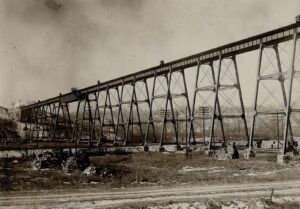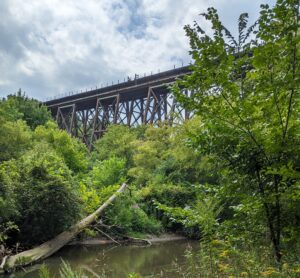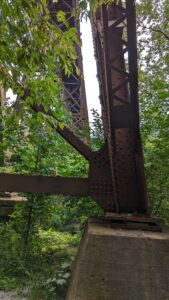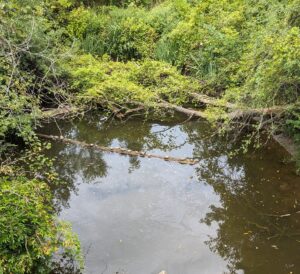Though my previous post was political and this one is personal, they share a common perspective about enhancing greenspace in the Toronto area. I support preserving the Greenbelt by preventing the construction of housing and highways in it. Railroads have long been a major part of the urban landscape – one not far from my home – but, as I will discuss, their detrimental impact is diminishing.
The Stephen Harper Trail
The Canadian Pacific Railway (CPR) mainline was built through Toronto in the mid-1880s and still operates as a freight line. The line going through Leaside (east-central Toronto) has an abandoned spur running north-south from Eglinton to York Mills, just east of Leslie St., about 2 kilometres from my home. As part of its Economic Action Plan to mitigate the effects of the recession of 2008 by investing in infrastructure, the Harper Government funded the removal of track and paving over of this spur. Referring to the neighbourhood, it is called the Don Mills Trail. It is approximately 3 kilometres long and in mainly places well-shaded. It is very flat, and excellent for walking, running, or cycling. As a regular walker and runner on the trail, I’ve gotten to know many of the other regulars. It is the single most significant and ongoing impact that the Harper Government has had on my life so, to give credit where credit is due, I call it the Stephen Harper Trail.
Greening the West Don High Bridge
Not far from the Stephen Harper Trail, the CPR mainline includes the West Don High Bridge over Wilket Creek Park. The original bridge was built in 1884, with a second track added in 1914. The combined bridge is an impressive 250 metres long and 30 metres high, composed of iron columns, reinforced with lattice ties, anchored in stone and cement piers. The The construction process brutalized the valley below the bridge, as this old photo demonstrates.

But, with the valley now protected as parkland, nature has reasserted itself, as these two photos show. I’m reminded that several impressionist artists painted their visions of the impact of industry, especially trains and factories, on the natural landscape. The Art Gallery of Ontario had an exhibit on this theme several years ago. What I see now is a reversal of what the impressionists observed, with this massive industrial artefact being absorbed in its natural setting.


I often bicycle or walk through the valley, and – to recall my recent discussion of Mendelssohn’s highest note – the section under the bridge is the emotional high point of these outings. The path is well-shaded, almost a tunnel of green. But not quite. Wilket Creek flows on my side with the bridge’s concrete anchoring piers right beside it. The bridge itself, a powerful structure of oxidized steel, is overhead. Occasionally, a freight train rumbles by. Altogether, this is an impressive and variegated spot, combining nature and human artefact.
Near the bridge, there is a quiet branch of the creek that is home to a nest of turtles. I was there a few days ago and saw seventeen of them lined up on a fallen tree branch, a photo I couldn’t resist.

My walks on the Stephen Harper trail and under the West Don Bridge are restorative. I consider myself fortunate to have easy and free access to so much public parkland. I want my fellow Torontonians to have similar access to greenspace, which is why I’m engaged in struggles to convert Billy Bishop Airport to parkland, to preserve Ontario Place, and to protect the Greenbelt.

Leave a Reply